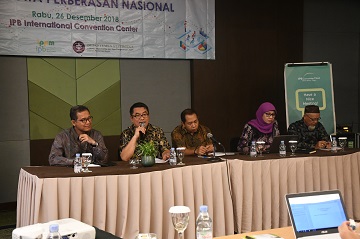IPB Readies to Bridge National Rice Data Difference

The chaos about Indonesia rice production data difference keeps on going. This is about the difference between calculation done by Area Frame Sampling (KSA) approach and calculation done by the Ministry of Agriculture (Kementan). KSA itself is a result of collaboration between the Central Bureau of Statistics (BPS) and Technology Assessment and Application Bureau (BPPT).
According to KSA, the raw area of paddy field reduced from 7.75 million hectare in 2013 to 7.1 million hectare in 2018. The harvest area potential in 2018 reaches 10.9 million hectare, while Kementan projects it to be 15.5 million hectare.
The difference in the data results in different rice production data. BPS mentioned that the production of milled dry grain in 2018 is as much as 56.54 million ton or equals with 32.42 million ton of rice, while Kementan projects it to be 83.3 million ton or equals with 48 million ton of rice.
“The successful implementation of food security development is very contingent on good planning. However, in its development, there are often contradicting statements from the government officials, especially on national rice data. Because of that, we from Institute for Research and Community Service (LPPM) and Statistics Department of Bogor Agricultural University (IPB) held this workshop to assess and fix the method to predict national rice production that has been used all this time,” said Dr. Eva Anggraini, the Deputy Head of LPPM IPB of Strategic Assessment and Scientific Publication during the KSA Method Workshop for National Rice Affairs in IPB International Convention Center (IICC), Bogor (26/12).
According to her, to solve this problem, an independent scientific study is needed to point out the advantages and disadvantages of each approach or even to give input to fix the alternative method.
Area Frame Sampling (KSA) is a sampling technique which uses field area as an enumeration unit. This method is based on Geographical Information System (SIG), remote sensing, information technology, and statistics to gather data and information regarding food crops, especially rice. Paddy field raw area includes 15 rice production centers. This year, it will be carried on to other 18 provinces.
According to Hermanto, Director of National Statistics Bureau, the KSA method is used to gather harvest area because it’s more objective and up to date (based on Android). The KSA approach doesn’t only involve BPS and BPPT, but also a national team which encompasses all related components, including Kementan and Lapan.
“We all have to be wise, the process is very long to gather data. Talking about rice data is talking about ready to consume rice. What will happens on field is that we have to measure the productivity, harvest area data, then obtain the dry harvest data. Afterwards, there is a dry mill conversion, then rice is produced. Even so, it still needs to be converted, how much for industry, and how much for consumption. There are too many things to do. So, we have to be wise. Through KSA approach, we hope that we can provide accurate and on time data and information to support National Food Security Program planning,” said Hermanto.
IPB Statistics Professor, Prof. Dr. Khairil Anwar Notodiputro, MS, said that KSA method is more systematic, thus also more accurate. However, there are inputs to perfect the KSA data, which is that there is a need to improve spatial data regarding cloud weather, solution on how to manage off-grid data and data that hasn’t incorporate seasons, because rice is a seasonal crop. (Ard)



